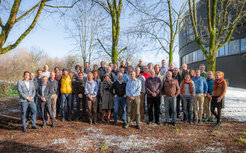ELT MICADO Instrument Passes Preliminary Design Review
MICADO, the first dedicated imaging system for ESO’s Extremely Large Telescope (ELT), has reached an important milestone in its design review. The MICADO consortium, together with a group of external experts from around the world, met at ESO’s Garching headquarters for a week of intense examination of the instrument’s optics, mechanics, software, electronics, and budget plan to identify any areas which needed further design work. After the meeting, the MICADO team addressed all of the major concerns raised during the review and the instrument has now formally passed its preliminary design review. A more detailed design phase is now underway, leading towards the final design review and construction of the instrument’s many components.

Equipped for both imaging and spectrographic observations, MICADO — the Multi-Adaptive Optics Imaging Camera for Deep Observations — will focus on near-infrared imaging and spectroscopy with unprecedented combination of sensitivity and accuracy. To compensate for the blurring effect of the atmosphere MICADO will use two different kinds of adaptive optics systems. One will use the telescope’s deformable M4 mirror to provide sharp images over a narrow field of view; the other uses the full capabilities of the MAORY adaptive optics module to provide a wider field of view.
MICADO will have the flexibility to observe many types of objects, and its spectroscopic capabilities will add significantly to our understanding of the composition of these objects. The instrument promises to explore some of the most compelling questions in astronomy, including how exoplanets form, how black holes at the centres of galaxies affect their hosts, and how the Universe has evolved over time.
More information
As the lead institute, MPE is responsible for the overall project management and system engineering, and represents the consortium towards ESO. The MICADO consortium comprises:

This picture was taken on 27 November 2018 during a four-day preliminary design review meeting regarding MICADO, one of the instruments to be installed at the ELT. During the meeting, the MICADO consortium delivered a data review package and took questions and comments from the review board.
MPE: Max-Planck-Institut für extraterrestrische Physik (Germany); PI: Ric Davies
MPIA: Max-Planck-Institut für Astronomie (Germany); CoI: Jörg-Uwe Pott
USM: Universitäts-Sternwarte München(Germany); CoI: Florian Lang-Bardl
IAG: Institute for Astrophysics of the Georg-August-Universität Göttingen (Germany); CoI: Harald Nicklas
NOVA: Netherlands Research School for Astronomy (represented by University of Groningen, the University of Leiden, and the NOVA optical/infrared instrumentation group based at ASTRON in Dwingeloo) (The Netherlands); CoI: Eline Tolstoy (at Univ. Groningen)
INAF-OAPD: National Institute for Astrophysics at the Observatory of Padova; CoI: Roberto Ragazzoni (at OAPD)
CNRS/INSU: Centre National de la Recherche Scientifique/Institut National des Sciences de l’Univers represented by LESIA, GEPI, Division Technique de l'INSU, UTINAM/OSU THETA and IPAG, France); CoI: Yann Clenet (at LESIA)
A*: An Austrian partnership (represented for MICADO by the University of Vienna, the University of Innsbruck, the University of Linz, and RICAM Linz [Austrian Academy of Sciences]) (Austria); CoI: Joao Alves (Uni. Wien)
FINCA: Finnish Centre for Astronomy with ESO, University of Turku, Finland; CoI: Jari Kottileinen (Univ. Turku). FINCA joined the MICADO consortium after the PDR.
ESO is an associate member of the MICADO consortium and is responsible for the development and procurement of the science detector systems that use the most advanced near-infrared detectors currently available.













